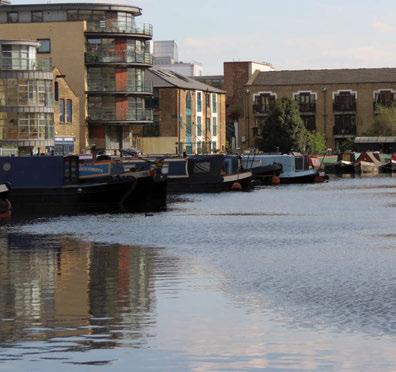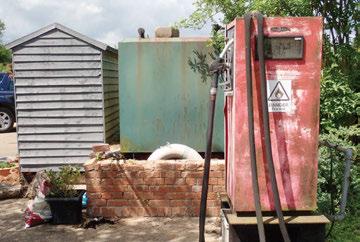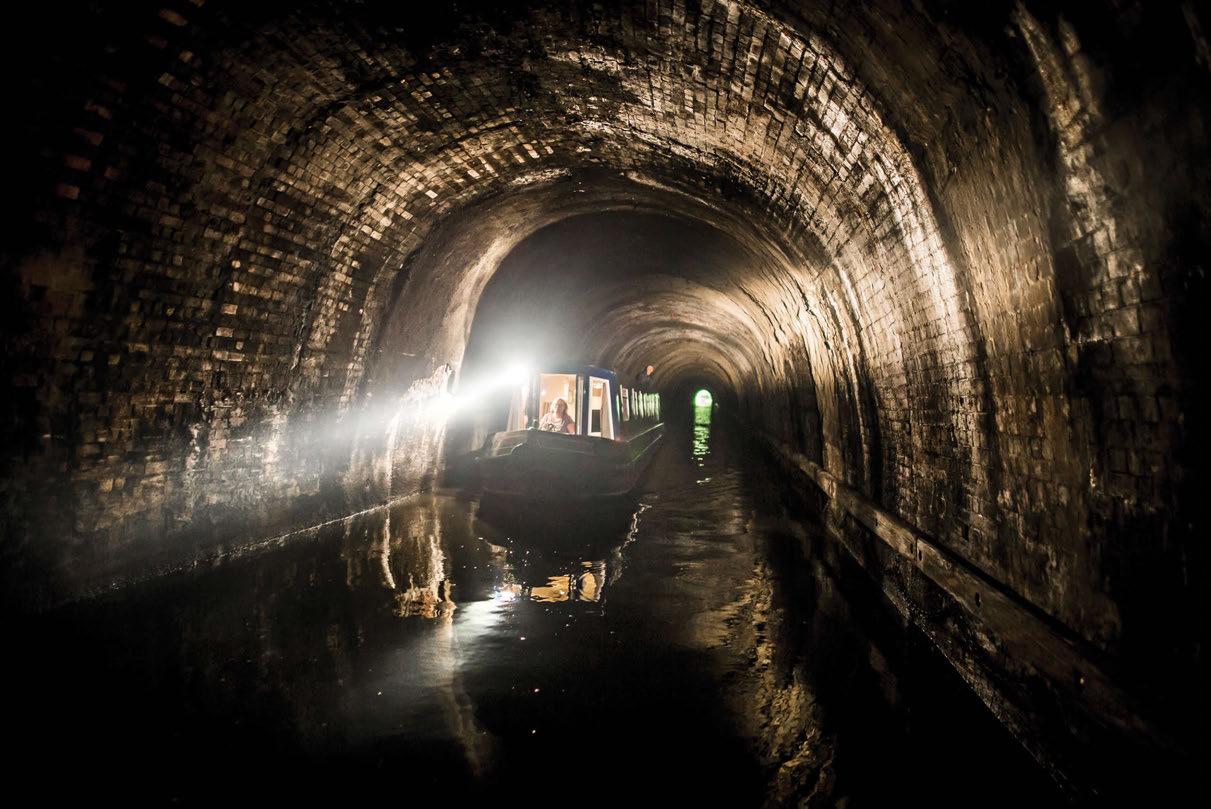
18 minute read
2019 Photo competition
On the Water and overall competition winner
The depths of Braunston Tunnel by Adam Smith.
All the winning entries from this year’s contest, plus an interview with judge Kieran Campbell
In this year’s new look photo competition, amateur and professional photographers were invited to submit their images to IWA across eight different picture categories. We received a total of 337 entries from talented snappers capturing the length and breadth of the country’s inland waterways, with the landscape category proving most popular with 85 submissions.
On the judging panel this year was Keiran Campbell from Jessops Photo who helped choose the top photographs from each category, as well as one overall winner. Congratulations to our winner Adam Smith, who received a £100 gift voucher to spend in IWA’s online shop and a canvas print provided by Jessops. Each of the category winners received a £25 gift voucher, and everyone shortlisted was sent an IWA T-shirt.
Built Environment winner

Millwall Inner Dock, Canary Wharf, London, by Mark Caldon.
Thank you to everyone who entered this year’s competition.
Entries are now open for 2020 – please visit waterways.org.uk/ photocomp for details of how to submit your pictures of our inland waterways for a chance to win.
Landscape winner

Misty morning on the Montgomery Canal at Maesbury by S.W. Roberts.
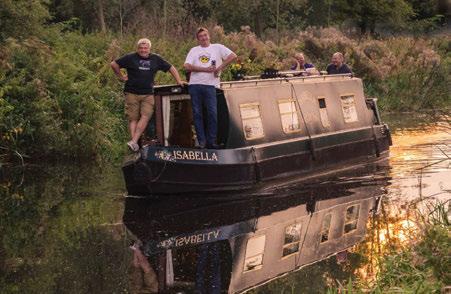

We Want to be Together winner
Chelmer & Blackwater Navigation at Boreham by Mark Caldon.
Restoration winner Wildlife winner

Ducks on the Gloucester & Sharpness Canal by David Fuller.


Up Close winner
Bridge 53 on the Trent & Mersey Canal by Pauline McGill.
Wonder in the Every Day winner

River Crouch at Hullbridge, Essex, by Nick Thornhill.
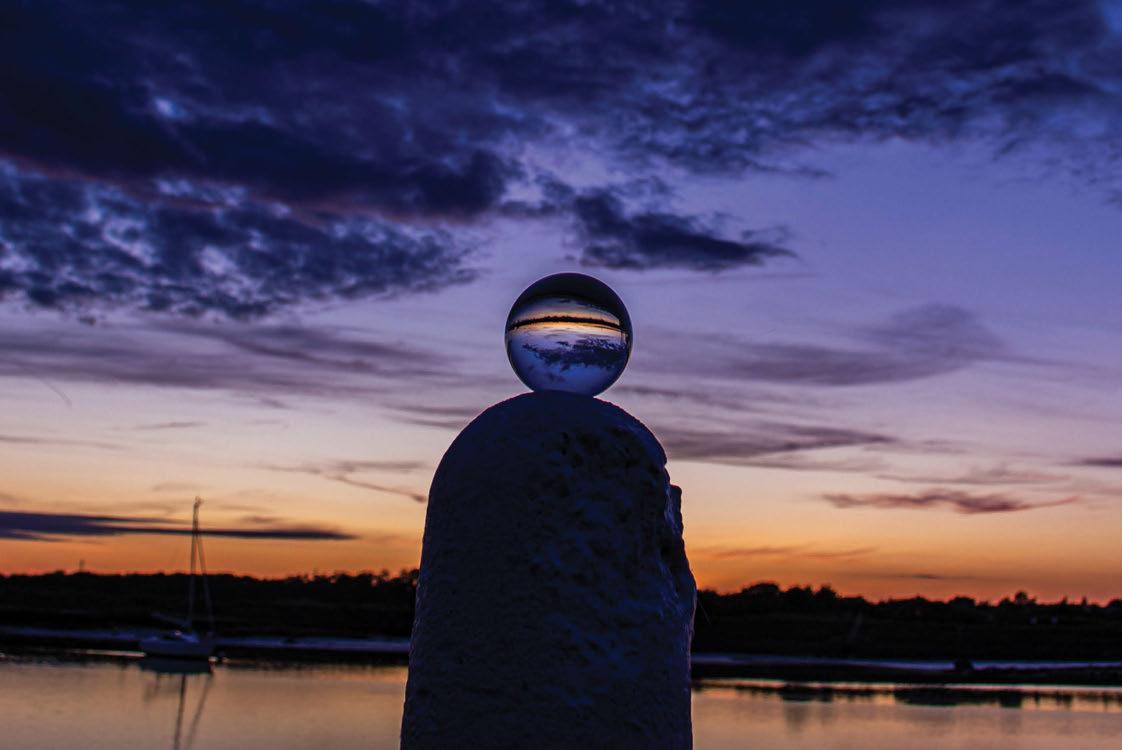
FIVE MINUTES WITH KEIRAN CAMPBELL
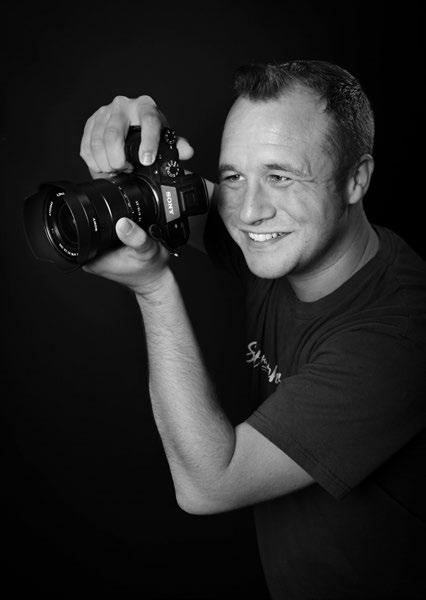
We ask our judge and retail operations partner from Jessops Photo for his top picture-taking tips
Tell us a bit about your photography background
I have worked for Jessops for 12 years and in that time I have used a vast amount of photographic equipment from compact cameras costing less than £100 to more professional, £3,000-plus cameras and lenses. If I’m not working with cameras, I can usually be found out and about with one in my hand during my spare time. I love to take photos of my four-year old son and have recently found a passion for motorsport photography. I currently use a Sony A7MKIII and a variety of lenses. My Instagram handle is @Kieran_42 if you want to check out some of my latest work.
What do you look for in a photograph?
When I look at a photograph, I ask myself a few questions: • Is the eye being drawn into the subject matter?
This could be through leading lines or using contrasting light. • Is the subject sharp and in focus? • How does the photo make me feel? Does it trigger some emotion, whether it’s happy, sad, angry, nostalgic?
Is there a set of rules that a photographer should follow when setting up the perfect shot?
The first thing to do is take your time. You need to work out what your focal point is going to be, and then move around to try different perspectives. Some of the best shots are taken from an angle rather than front on. Think about your leading lines and follow the rule of thirds to help with the composition of the photograph.
Make sure you are passionate about your subject as this will be reflected in the photograph. Also, don’t be afraid to try something different.
When is the best time of day to take a photograph?
The ‘golden hour’ – approximately one hour after sunrise or before sunset – is the best time for most subject matters.
What do you think of the calibre of submissions in this competition?
The standard of photography submitted has been really high; it was really difficult to judge the category winners.
What made you choose the overall winning photo?
There were a few things that made Adam’s photograph taken inside Braunston Tunnel stand out as the winner. I loved the use of the canal as the leading line with the light following it, the symmetry of the reflection, and the way that the photographer used the convergence point with all the lines drawing you into the heart of the photo rather than pushing you away. It is a really technical shot which was very difficult to capture. It was shot in extremely low light with a bright lamp coming towards the camera – to get the exposure right and balance that with a shutter speed to freeze the moment is no mean feat. It shows a very talented photographer and a worthy winner of this competition.
What is the most popular type of camera for taking waterways photos?
I am slightly biased towards the Sony Mirrorless. It’s all about what feels good and comfortable in the hand; there is nothing worse than using a camera you find uncomfortable. You’d be surprised how many people use their phones and get great results. What’s more important is what you do with the photo once you have it.
Any other advice for budding photographers?
Do what makes you happy. If you want to progress into a more professional field then be prepared for, or even seek out, constructive criticism. If that’s not what you want, then as long as you’re happy with the progress you’re making then just keep shooting what you love.
The biggest mistake most people make though, is that they keep their photos under wraps on their phone or on a hard drive. The greatest pleasure I get from photography is seeing a photo I have taken in print form and having something tangible rather than digital to show for it. Viewing a printed photo is completely different to viewing it on a screen; a screen is back lit and, as a result, photos always appear brighter. The true test of any photo is: does it look better in print than on screen? If the answer is yes (and it won’t always be), then you have nailed that shot. Generally speaking I print pictures at 9in by 6in and I stand back to admire it before getting closer.
All that is left is for me to say is well done to everyone who entered the competition and congratulations to the category winners and to Adam Smith, the overall winner. There were some truly stunning photographs in the competition and everyone should be proud of their shots.
About Jessops
Known as the high-street photography experts, Jessops has 47 stores across the UK, selling photographic equipment for both amateur and professional photographers as well as printing services including photo prints, cards, photobooks and personalised gifts through Jessops Photo. Jessops offers helpful advice on all your photographic needs both in-store and online through its friendly and approachable expert Photosmiths. Please visit jessops.com or photo.jessops.com.
TALK
THE TALK WALK

THE WALK
IWA’s Towpath Walks have been offering members, tourists and Londoners alike two-hour constitutionals in our capital city for more than 40 years. Charlie Forman gives a guide’s perspective
The guided routes are popular with people from all walks of life and nationalities. E s T on E I r IE F A r M IWA Towpath Walks guide Charlie Forman in action.

I’ve been with Towpath Walks for five years, although the scheme itself has been running for much longer than that, since 1977. I joined as a newly qualified guide, realising it would be a golden opportunity to have a ready-made audience of walkers expecting a professional service, as well as to indulge my love of the waterways and social history. I’m very much fascinated by what makes places work, and canals were a critical part of the infrastructure of our cities. Understanding how they operated and supplied the city and the people who worked on them was my way in, rather than being interested in the boats themselves. I don’t go on the canals that often, but I do walk alongside them regularly. I’m a volunteer at the London Canal Museum too, so a lot of the expertise from there has filtered through and helps when guiding the walks. I think I’ve got more interested in some of the boating and warehousing details as a result.
Our groups contain quite a mix of people. There are a few dedicated members of IWA who come along, and you have to be careful that you get your facts right! They sometimes know more than I do! And a lot of people are London locals who are just keen to explore their own city. They’re a great audience to have. You also get a number of tourists. The canals are effectively a linear park cutting through the middle of our city, so for the tourist it’s an amazing way to see the capital without the noise and pollution of walking the streets. Obviously the towpaths themselves can also get quite busy, but it’s certainly a very different perspective they offer. Thanks to the quality of our guiding, I think all our customers leave feeling satisfied they’ve gained an insight into London that they would never otherwise have had.
Challenges
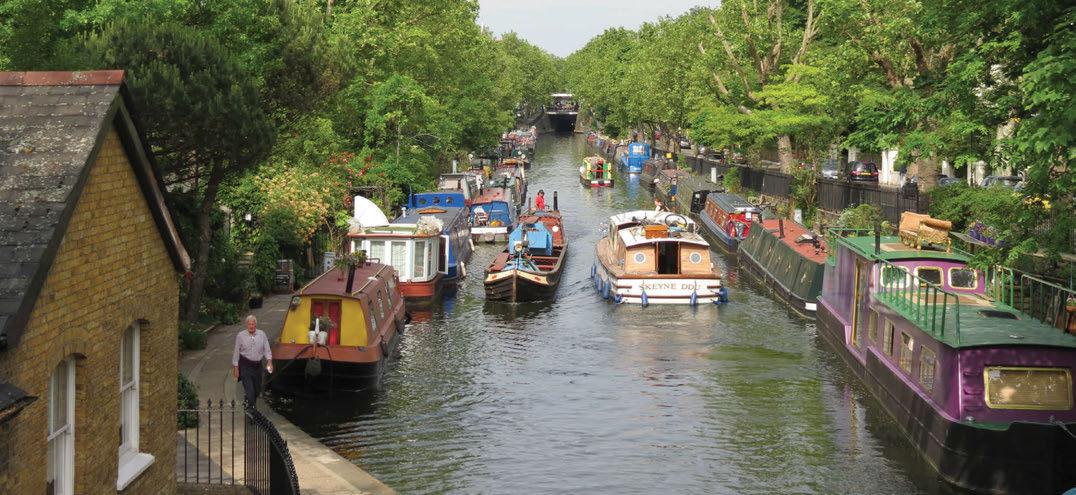
Because they’re based on a towpath, our walks aren’t difficult to follow, but they can be quite hard to manage because there isn’t a lot of space. Sunny weekends can be particularly problematic – a combination of lots of other people out enjoying the canal, and big groups on our walking tours. The two together can be challenging. Throw cyclists into the mix and it can become even more problematic. I don’t want to demonise cyclists (I can’t, because I am one myself), but a bit more courtesy and common sense from some of them would certainly help. Most, fortunately, are very respectful.
King’s Cross to Camden and Little Venice to Camden are probably our two most popular walks, but you often get surprises. It’s hard to predict. You can do the same walk twice and on one occasion get five people and the next time 25 or even 30, despite the weather conditions being apparently no different. Other walks that can pull in a big crowd are West India Docks and the Olympic Park. The way the Olympic Park has developed is very much intertwined with the history of the waterways that are running through it, so that’s always a good story to tell.
Personal favourite
As a guide, one of the walks I enjoy most is Kings Cross to Camden. You can chart more of the history of the canal in that walk than in any other. It’s all there. The great success of the planning of the area has been the preservation of some of the old goods yards and infrastructure, which you can highlight as something that connects the canal with its past. Of course, there are also disputes about how successful the whole development is, but I personally think it’s one of the areas that has been done best. The restored gas holders, for example, and the nature reserve. You’ve got everything in one spot, almost. It’s a great walk and I always enjoy it.
At the moment we offer somewhere between 15 and 20 different walking routes. Some are a bit difficult to get to so aren’t run very often. We’re always looking for new places. The walks are relatively flat so can be excellent for people whose mobility isn’t good. Not all the access points to towpaths have ramps (some require getting up or down quite steep stairs) and sometimes the surface can be rough. Having said that, I’ve guided people who aren’t strong walkers and have still managed to finish pretty much on time. And I’ve done walks with people using mobility scooters, which is perfectly manageable if you can plan ahead.
The Little Venice to Camden route is among the most popular walks.
Weather woes
Our service is a partnership with London Walks (walks.com), which has a year-round programme and gives us a guaranteed slot every other Sunday afternoon. The quid pro quo is that we always have to be available, whether it’s a lovely day in June or a snowstorm at the beginning of January. We’re there come rain or shine and, in one case, fog. On that particular occasion, in the Lee Valley, I could basically only offer an audio commentary. I had to describe what people would have seen had there not been such adverse conditions. Thankfully they all got into the spirit of it. The fog was so thick that when I went home at the end of the walk I got lost twice myself! We never cancel. What I say to people on a really bad day is that I’m going to carry on doing this walk until there’s no one left to listen to me.
There is something in the walks for everybody, from primary school children right up to people who have memories of the canals as working, industrial waterways. It’s one of the things that make the walks come alive and keep them fresh for me every time. Another thing is that the canals are changing quite fast, so you have to stay alert to that. Part of their story is this change, and how we’ve managed to save the canals over the last 40 years from potentially being infilled and built over with new office blocks, specifically around City Basin. Finally, it’s important to recognise that another motivation for all of us guides is the fundraising aspect. If you’ve got 25 people per walk, you’re probably going to pick up the best part of £200 or more. That’s quite a significant contribution to IWA. Add all that together over the years and it’s a terrific sum we’ve raised – over £48,000.
Join the team
Towpath Walks is looking for volunteer guides to join the existing team at the IWA Towpath Walks Society, in London. The society, in partnership with London Walks, carries out a regular series of guided walks along London’s canals. The walks last just over two hours and take place on two Sunday afternoons each month starting at a tube or DLR station. They’re a great way to introduce people to the waterways, and to raise money for IWA.
All that is needed is an interest in waterways, an enjoyment of sharing your knowledge with others and a love of walking. A full briefing will be provided for the series and each individual walk. You will be part of a team so you can do as many or as few walks as you like. There are a set of walking routes already planned and being carried out, so there is little preparation to be done. However, if you would like to add more walks to our programme then this may be possible.
If you would like to help, please contact Roger Wilkinson at roger.wilkinson@waterways.org.uk or by calling 020 3612 9624.
KING'S CROSS TO CAMDEN
Roger Wilkinson highlights points of interest along the popular towpath walk
5B Four gasholders have now been re-erected above St Pancras Lock: three of which house apartment blocks. The fourth is a public open space called Gasholder Green. They were once part of the gasworks of Imperial Gas Light & Coke Co, a customer of the canal, which opened on the off-side bank in 1824, next to the site of King’s Cross Station. Coal was delivered, and ashes and by-products taken out, via a canal basin. In 1810 William Agar bought Elm Grove, an estate across the intended line of the canal. He was possibly related to George Agar, one of the canal’s proprietors. He refused access to the Canal Company for a long time, until eventually, after law suits and payment of compensation, he relented. Later, his son built a huge shanty-town on the land (Agar Town), described by Dickens as the worst slums in London. They were demolished in 1868 for Midland Railway’s goods yards. After they subsequently closed, the area was redeveloped as Elm Village.
Hawley Lock
8
Kentish Town Lock
Hampstead Lock Camden Lock
9 10
Walker’s Quay
Canal Information Centre/Starbucks Camden Road Bridge 7
Elm Village

7At Camden Road Bridge, then Camden Street Bridge, note the grooves worn by tow-ropes picking up grit from the path. The River Fleet passes in a culvert under the canal between these bridges.
6
8Kentish Town Bridge is followed by Kentish Town Lock and Hawley Lock (named after the landowner, Sir Henry Hawley). The building of the former Camden Brewery (off-side, 1900) was rebuilt in 1982 as the studios of new breakfast TV company, TV-AM. It’s now MTV’s studios.
Walker's Quay (left, off-side) is where the Jenny Wren trip-boat has run from since 1968.

9Hampstead Road Locks are the only surviving pair of locks and the top locks of the 12 taking the canal down 86ft to Limehouse Basin. 10 The former lock house is an 1815 castellated cottage, now Starbucks and a canal information centre. Regular through freight traffic on the Regent’s Canal continued until the 1960s, while some timber trade continued until 1970.
3Turn off the towpath and up a ramp on the right, which leads to the former Great Northern Railway Co’s Goods Yard, on the high ground to the north of the towpath. This includes the Granary Building (Lewis Cubitt, 1852) which once had an interchange basin leading off the canal, with wharves for barges under the building. The Goods Yard redevelopment, as King’s Cross Central, is one of central London’s biggest developments. The basin (infilled at the end of WWI) is now the site of Granary Square.
4On the west side of Granary Square, the Eastern & Western Coal Drops (1850s) have been refurbished to a Thomas Heatherwick design. With the Fish and Coal Offices (1852-7), this area is now a smart precinct of shops and cafés.
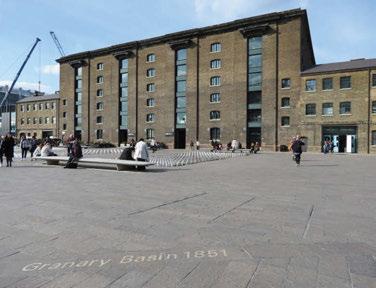
5a Walk past the Fish and Coal Offices at basement level, turning left to re-join the towpath below St Pancras Lock. This basement was the coal depot’s extensive stables (400 horses) which included a hospital for horses.
Camley Street Natural Park (off-side below the lock) was set up in 1985 by London Wildlife Trust & LB Camden on the site of the old railway coal chute area and accommodates hundreds of plant species.
St Pancras Lock itself, like all locks on the Regent’s Canal, was built as a pair to cope with heavy traffic. It was singled (with the second lock chamber rebuilt as an automatic weir) as part of economising measures in the 1980s.
The waterpoint (behind the lock house) is a George Gilbert Scott design (1872). It was the water tank for locomotives. The structure was moved from St Pancras Station in 2001 to its present site to make space for Eurostar. It is presently in use (temporarily) by St Pancras Cruising Club as its clubhouse.
St Pancras Lock
5b Gasholders
St Pancras Cruising Club
5A Granary Square York Way/ Maiden Bridge
2
2Walk to York Way / Maiden Lane Bridge for a view back (east) to Islington Tunnel. Some 960 yards (878m) long it has no towpath, so boats were legged through until a tug was introduced in 1826. This tugging service operated until the 1930s. The unusually large dimensions of the tunnel and waterway stem from its design as an ‘import-export’ canal, able to take Thames lighters bringing cargoes from London Docks.
The stop gates next to Maiden Lane Bridge were installed during WWII to lessen damage by flooding in the event of a breach. This was critical, as main lines serving King’s Cross Station go under the canal just the other side of the bridge.
Maiden Lane Bridge itself now carries York Way. Nearby were the dust-heaps that feature in Dickens’ Household Words magazine.
Camley Street Natural Park
4 3
Kings Place
1
Battlebridge Basin Islington Tunnel
London Canal Museum
St Pancras Station King's Cross Station
1The walk starts at Battlebridge Basin, which takes its moniker from the original name of the area, and a legend of a battle between Boudicca and the Romans. The basin was completed in 1825 for landowner William Horsfall. Two warehouses remain: one was Porter’s bottling works (once the London bottling plant for Guinness, now a design studio), the other houses London Canal Museum.
London Canal Museum is halfway along the basin. Formerly Carlo Gatti’s warehouse, it still has ice wells and dates from 1856. The museum itself was opened in 1992 by HRH The Princess Royal, who continues to be a patron.
Swanky King's Place is also worth a mention. It opened in 2008 with concert halls, a restaurant and café, and is the HQ of the Guardian and Observer newspapers.
